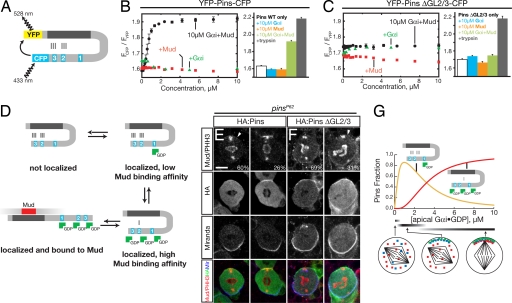Fig. 3.
Pins undergoes a conformational change into a high Mud binding affinity state in response to Gαi binding to GoLocos 2 and 3. (A) Architecture of the Pins FRET sensor. (B) Full transition to the Pins open state requires both Gαi·GDP and Mud. Shown in the bar graph are the FRET ratios for the WT Pins FRET sensor ([YFP–Pins–CFP] = 200 nM) with various combinations of Gαi·GDP and Mud ligands present at 10 μM concentration and after trypsin digestion. Error bars equal one SD (n = 3). (C) Pins with inactivated GoLocos 2 and 3 is unable to transition to open state with Gαi·GDP and Mud present. Shown in the bar graph are the FRET ratios for the Pins ΔGL2/3 FRET sensor ([YFP–Pins–CFP] = 200 nM) with various combinations of Gαi·GDP and Mud ligands present at 10 μM concentration. Error bars equal one SD (n = 3). (D) Model for coupled Gαi·GDP and Mud binding and relationship to Pins conformational states. (E) HA:Pins can rescue Mud localization in pins larval neuroblasts. Pins localization is detected by anti-HA antibody, Mud is detected by anti-Mud antibody, and the mitotic stage is determined by anti-phospho histone H3 (α-PHH3) antibody. Moderate (60%) or strong (26%) Mud apical crescents were observed in metaphase neuroblasts. The localization of Mud to the spindle poles is independent of Pins activity (13). Miranda was used as a basal marker. (F) Pins with inactivated GoLocos 2 and 3 fails to rescue Mud apical enrichment in pins larval neuroblasts. Staining is as in E. Although HA:Pins ΔGL2/3 is correctly localized, only weak or moderate Mud apical staining was observed in 31% of metaphase neuroblasts. (Scale bar: E and F, 5 μm.) (G) Pins–Gαi response profile. The concentration of Pins with Gαi bound at GoLoco1 and Gαi-saturated Pins is shown as a function of Gαi concentration based on the model shown in D. This model uses the intrinsic affinity of Gαi for the GoLocos (Kd = 530 nM) and assumes that the inactive form of Pins is favored 1,000:1 over active Pins in the absence of Gαi or Mud. Simulations were performed with Berkeley Madonna. Predicted neuroblast phenotypes with the state of cortical polarity (red, Mud; blue, Pins; green, Gαi) and spindle positioning are shown at low, medium, and high Gαi concentration ranges.

